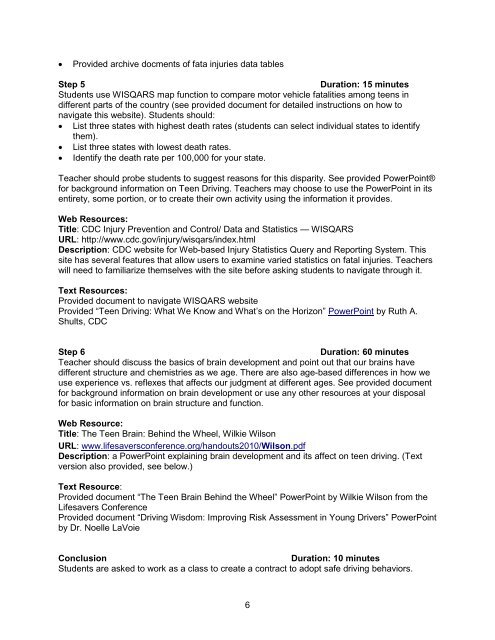Distracted Drivers - Centers for Disease Control and Prevention
Distracted Drivers - Centers for Disease Control and Prevention
Distracted Drivers - Centers for Disease Control and Prevention
Create successful ePaper yourself
Turn your PDF publications into a flip-book with our unique Google optimized e-Paper software.
• Provided archive docments of fata injuries data tables<br />
Step 5<br />
Duration: 15 minutes<br />
Students use WISQARS map function to compare motor vehicle fatalities among teens in<br />
different parts of the country (see provided document <strong>for</strong> detailed instructions on how to<br />
navigate this website). Students should:<br />
• List three states with highest death rates (students can select individual states to identify<br />
them).<br />
• List three states with lowest death rates.<br />
• Identify the death rate per 100,000 <strong>for</strong> your state.<br />
Teacher should probe students to suggest reasons <strong>for</strong> this disparity. See provided PowerPoint®<br />
<strong>for</strong> background in<strong>for</strong>mation on Teen Driving. Teachers may choose to use the PowerPoint in its<br />
entirety, some portion, or to create their own activity using the in<strong>for</strong>mation it provides.<br />
Web Resources:<br />
Title: CDC Injury <strong>Prevention</strong> <strong>and</strong> <strong>Control</strong>/ Data <strong>and</strong> Statistics — WISQARS<br />
URL: http://www.cdc.gov/injury/wisqars/index.html<br />
Description: CDC website <strong>for</strong> Web-based Injury Statistics Query <strong>and</strong> Reporting System. This<br />
site has several features that allow users to examine varied statistics on fatal injuries. Teachers<br />
will need to familiarize themselves with the site be<strong>for</strong>e asking students to navigate through it.<br />
Text Resources:<br />
Provided document to navigate WISQARS website<br />
Provided “Teen Driving: What We Know <strong>and</strong> What’s on the Horizon” PowerPoint by Ruth A.<br />
Shults, CDC<br />
Step 6<br />
Duration: 60 minutes<br />
Teacher should discuss the basics of brain development <strong>and</strong> point out that our brains have<br />
different structure <strong>and</strong> chemistries as we age. There are also age-based differences in how we<br />
use experience vs. reflexes that affects our judgment at different ages. See provided document<br />
<strong>for</strong> background in<strong>for</strong>mation on brain development or use any other resources at your disposal<br />
<strong>for</strong> basic in<strong>for</strong>mation on brain structure <strong>and</strong> function.<br />
Web Resource:<br />
Title: The Teen Brain: Behind the Wheel, Wilkie Wilson<br />
URL: www.lifesaversconference.org/h<strong>and</strong>outs2010/Wilson.pdf<br />
Description: a PowerPoint explaining brain development <strong>and</strong> its affect on teen driving. (Text<br />
version also provided, see below.)<br />
Text Resource:<br />
Provided document “The Teen Brain Behind the Wheel” PowerPoint by Wilkie Wilson from the<br />
Lifesavers Conference<br />
Provided document “Driving Wisdom: Improving Risk Assessment in Young <strong>Drivers</strong>” PowerPoint<br />
by Dr. Noelle LaVoie<br />
Conclusion<br />
Duration: 10 minutes<br />
Students are asked to work as a class to create a contract to adopt safe driving behaviors.<br />
6
















